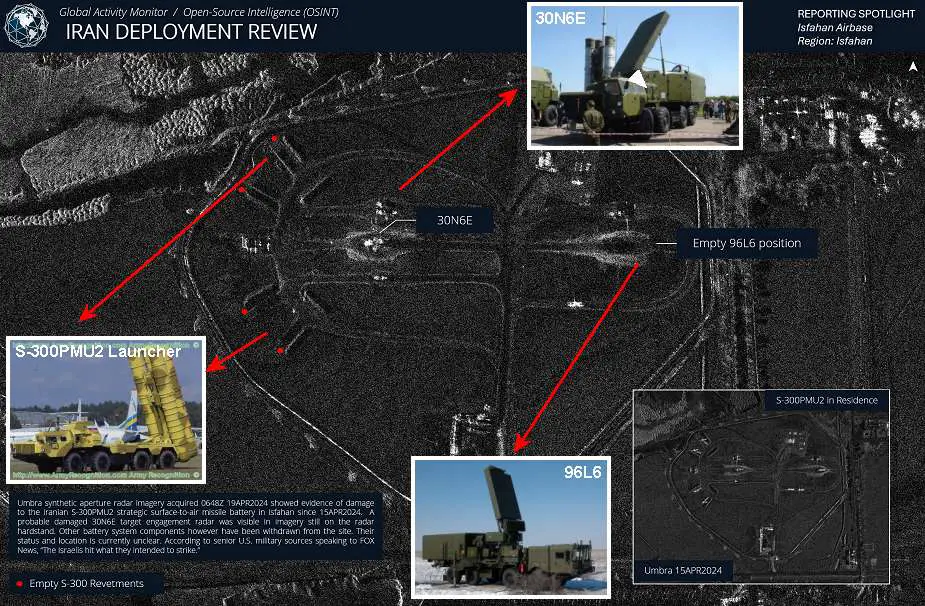Breaking news
Breaking News: Israel Strikes Iranian Air Base Damaging S-300PMU2 Air Defense Systems and 30N6E Radar.
On Friday, April 19, 2024, Israel conducted a targeted airstrike hitting a major air base and a nuclear facility in central Iran. This action was in direct response to Iran's drone and missile assault on Israeli territory on April 14, 2024, which itself was a retaliation for an earlier Israeli strike on the Iranian consulate in Damascus. According to American media reports, the Israeli drones damaged key components of Iran's air defense infrastructure, including a battery of the advanced S-300 PMU2 air defense missile system and a 30N6E, the engagement radar of the S-300PMU2 battery.
Follow Army Recognition on Google News at this link

A satellite image from April 19, 2024, shows damage to the Iranian S-300PMU2 air defense missile system and target acquisition radar 30N6E. (Picture source X Account Chris Biggers)
The initial Iranian attack on April 14 involved a large-scale offensive with drones and missiles launched not only from Iran but also from allied groups in Iraq, Syria, Lebanon, and Yemen. Despite the scale of the attack, the majority were intercepted by Israeli defenses. The recent Israeli retaliation targeted military installations near Isfahan, marking a significant intensification in the conflict. Satellite images shared on social media platforms show the extent of the damage inflicted on Iranian military capabilities, raising concerns about further regional destabilization.
The political situation in terms of Israel's defense against Iran, especially after the attacks on April 14, 2024, has become significantly tense. Iran's direct assault involved launching approximately 300 drones and missiles at Israel, which was a retaliatory act for a suspected Israeli strike on an Iranian military figure in Damascus earlier in April. This marked a major escalation and the first direct confrontation between Iran and Israel, highlighting the serious potential for a broader conflict.
Israel's response to the Iranian strikes was robust, with the Israeli Defense Forces (IDF) successfully intercepting the majority of the incoming threats. High-level meetings were convened by Israeli Prime Minister Benjamin Netanyahu and the defense leadership to assess the situation and plan further responses. The Israeli government, while prepared for defensive and offensive operations, indicated a preference to avoid a significant escalation, focusing instead on defense readiness and the strength of their aerial defense systems.
Internationally, the incident drew widespread reactions. The United States, along with G7 nations, condemned the attacks and reiterated their support for Israel, emphasizing the need for restraint and de-escalation. European and other global leaders also expressed deep concerns about the potential for this confrontation to destabilize the region further.
The S-300 PMU2, also known as the SA-20B Gargoyle by NATO, is a highly sophisticated Russian air defense missile system designed to provide superior air defense capabilities against a variety of aerial threats. This system is an upgrade of the earlier S-300 versions, featuring enhanced radar, missile capabilities, and electronic countermeasures.
The system's core consists of the 48N6E2 missile, capable of engaging targets up to 195 kilometers away and at altitudes ranging from 10 meters to 27 kilometers. This makes the S-300PMU2 effective against a broad spectrum of threats including aircraft, cruise missiles, and even ballistic missiles under certain conditions. Its advanced radar system, the 30N6E, plays a crucial role in target acquisition and guidance, enabling the system to track and engage multiple targets simultaneously with high accuracy.
The 30N6E radar, an essential component of the S-300 PMU2 missile system, plays a critical role in the detection, tracking, and engagement of aerial threats. This radar excels in precision tracking, which is vital for the accurate guidance of missiles toward incoming targets. It is equipped to handle multiple engagements simultaneously, allowing the S-300PMU2 to address several threats at once, significantly boosting its combat effectiveness.
In terms of technical capabilities, the 30N6E boasts a detection range of approximately 300 kilometers, enabling early identification of potential threats from considerable distances. It can track targets at varying altitudes, enhancing its utility in defending against a diverse array of aerial threats, including high-altitude reconnaissance aircraft, mid-level cruise missiles, and lower-flying unmanned aerial vehicles. This broad detection envelope ensures that the S-300PMU2 can maintain a protective buffer around critical infrastructure or defended zones, contributing greatly to airspace security and integrity.
Israel's airstrike on April 19, 2024, targeting strategic military and nuclear facilities in Iran, was a calculated response to the earlier Iranian attacks against Israeli territory on April 14. This retaliation, which damaged crucial components of Iran's air defense system including the S-300PMU2 missile system and the 30N6E radar, illustrates the ongoing escalation and complexity in the geopolitical tensions between the two nations. Israel's decisive action underscores its commitment to maintaining national security and deterring future threats, signaling its readiness to engage militarily to protect its interests.
Defense News April 2024

























